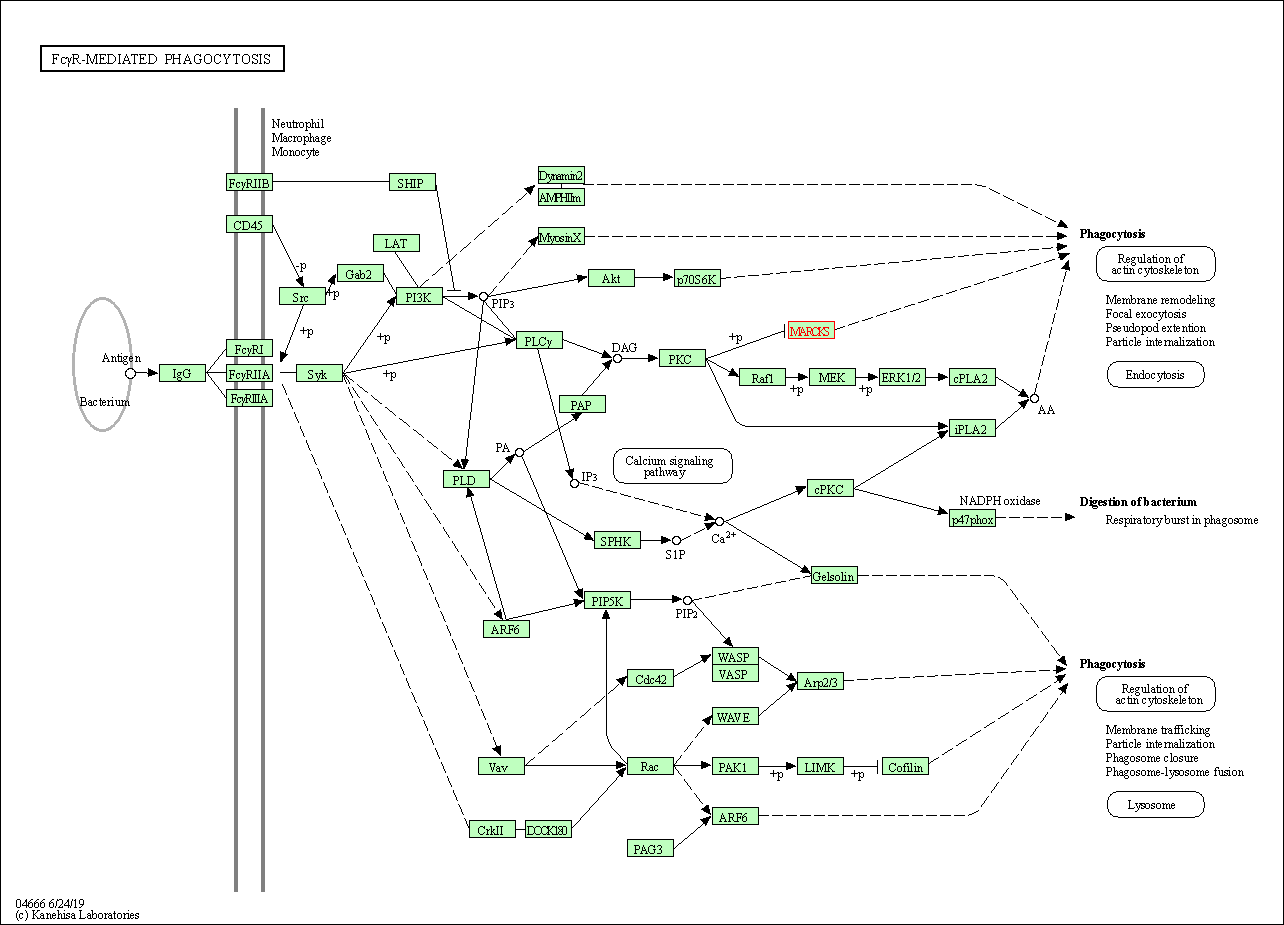Target Information
| Target General Information | Top | |||||
|---|---|---|---|---|---|---|
| Target ID |
T05351
(Former ID: TTDI02121)
|
|||||
| Target Name |
Myristoylated alanine-rich C-kinase substrate (MARCKS)
|
|||||
| Synonyms |
Protein kinase C substrate, 80 kDa protein, light chain; PRKCSL; PKCSL; Myristoylated alaninerich Ckinase substrate; MACS; 80KL protein; 80K-L protein
Click to Show/Hide
|
|||||
| Gene Name |
MARCKS
|
|||||
| Target Type |
Clinical trial target
|
[1] | ||||
| Disease | [+] 2 Target-related Diseases | + | ||||
| 1 | Chronic obstructive pulmonary disease [ICD-11: CA22] | |||||
| 2 | Lung cancer [ICD-11: 2C25] | |||||
| Function |
MARCKS is the most prominent cellular substrate for protein kinase C. This protein binds calmodulin, actin, and synapsin. MARCKS is a filamentous (F) actin cross-linking protein.
Click to Show/Hide
|
|||||
| UniProt ID | ||||||
| Sequence |
MGAQFSKTAAKGEAAAERPGEAAVASSPSKANGQENGHVKVNGDASPAAAESGAKEELQA
NGSAPAADKEEPAAAGSGAASPSAAEKGEPAAAAAPEAGASPVEKEAPAEGEAAEPGSPT AAEGEAASAASSTSSPKAEDGATPSPSNETPKKKKKRFSFKKSFKLSGFSFKKNKKEAGE GGEAEAPAAEGGKDEAAGGAAAAAAEAGAASGEQAAAPGEEAAAGEEGAAGGDPQEAKPQ EAAVAPEKPPASDETKAAEEPSKVEEKKAEEAGASAAACEAPSAAGPGAPPEQEAAPAEE PAAAAASSACAAPSQEAQPECSPEAPPAEAAE Click to Show/Hide
|
|||||
| 3D Structure | Click to Show 3D Structure of This Target | AlphaFold | ||||
| HIT2.0 ID | T96U07 | |||||
| Drugs and Modes of Action | Top | |||||
|---|---|---|---|---|---|---|
| Clinical Trial Drug(s) | [+] 2 Clinical Trial Drugs | + | ||||
| 1 | BIO-11006 | Drug Info | Phase 2 | Chronic obstructive pulmonary disease | [2] | |
| 2 | BIO-11006 | Drug Info | Phase 2 | Non-small-cell lung cancer | [3] | |
| Mode of Action | [+] 1 Modes of Action | + | ||||
| Inhibitor | [+] 2 Inhibitor drugs | + | ||||
| 1 | BIO-11006 | Drug Info | [1] | |||
| 2 | BIO-11006 | Drug Info | [4] | |||
| Cell-based Target Expression Variations | Top | |||||
|---|---|---|---|---|---|---|
| Cell-based Target Expression Variations | ||||||
| Different Human System Profiles of Target | Top |
|---|---|
|
Human Similarity Proteins
of target is determined by comparing the sequence similarity of all human proteins with the target based on BLAST. The similarity proteins for a target are defined as the proteins with E-value < 0.005 and outside the protein families of the target.
A target that has fewer human similarity proteins outside its family is commonly regarded to possess a greater capacity to avoid undesired interactions and thus increase the possibility of finding successful drugs
(Brief Bioinform, 21: 649-662, 2020).
Human Pathway Affiliation
of target is determined by the life-essential pathways provided on KEGG database. The target-affiliated pathways were defined based on the following two criteria (a) the pathways of the studied target should be life-essential for both healthy individuals and patients, and (b) the studied target should occupy an upstream position in the pathways and therefore had the ability to regulate biological function.
Targets involved in a fewer pathways have greater likelihood to be successfully developed, while those associated with more human pathways increase the chance of undesirable interferences with other human processes
(Pharmacol Rev, 58: 259-279, 2006).
Biological Network Descriptors
of target is determined based on a human protein-protein interactions (PPI) network consisting of 9,309 proteins and 52,713 PPIs, which were with a high confidence score of ≥ 0.95 collected from STRING database.
The network properties of targets based on protein-protein interactions (PPIs) have been widely adopted for the assessment of target’s druggability. Proteins with high node degree tend to have a high impact on network function through multiple interactions, while proteins with high betweenness centrality are regarded to be central for communication in interaction networks and regulate the flow of signaling information
(Front Pharmacol, 9, 1245, 2018;
Curr Opin Struct Biol. 44:134-142, 2017).
Human Similarity Proteins
Human Pathway Affiliation
Biological Network Descriptors
|
|
|
There is no similarity protein (E value < 0.005) for this target
|
| KEGG Pathway | Pathway ID | Affiliated Target | Pathway Map |
|---|---|---|---|
| Fc gamma R-mediated phagocytosis | hsa04666 | Affiliated Target |

|
| Class: Organismal Systems => Immune system | Pathway Hierarchy | ||
| Degree | 2 | Degree centrality | 2.15E-04 | Betweenness centrality | 9.58E-07 |
|---|---|---|---|---|---|
| Closeness centrality | 2.02E-01 | Radiality | 1.35E+01 | Clustering coefficient | 0.00E+00 |
| Neighborhood connectivity | 1.90E+01 | Topological coefficient | 5.45E-01 | Eccentricity | 12 |
| Download | Click to Download the Full PPI Network of This Target | ||||
| Target Regulators | Top | |||||
|---|---|---|---|---|---|---|
| Target-regulating microRNAs | ||||||
| Target Profiles in Patients | Top | |||||
|---|---|---|---|---|---|---|
| Target Expression Profile (TEP) | ||||||
| References | Top | |||||
|---|---|---|---|---|---|---|
| REF 1 | Inhibition of myristoylated alanine-rich C kinase substrate (MARCKS) protein inhibits ozone-induced airway neutrophilia and inflammation. Exp Lung Res. 2010 Mar;36(2):75-84. | |||||
| REF 2 | ClinicalTrials.gov (NCT00648245) Effectiveness and Safety of BIO-11006 Inhalation Solution to Treat the Overproduction of Mucus and Inflammation in COPD. U.S. National Institutes of Health. | |||||
| REF 3 | ClinicalTrials.gov (NCT03472053) A Study of BIO-11006 in the Treatment of Advanced Non-Small Cell Lung Cancer. U.S. National Institutes of Health. | |||||
| REF 4 | An Inhaled Inhibitor of Myristoylated Alanine-Rich C Kinase Substrate Reverses LPS-Induced Acute Lung Injury in Mice. Am J Respir Cell Mol Biol. 2016 Nov;55(5):617-622. | |||||
If You Find Any Error in Data or Bug in Web Service, Please Kindly Report It to Dr. Zhou and Dr. Zhang.

